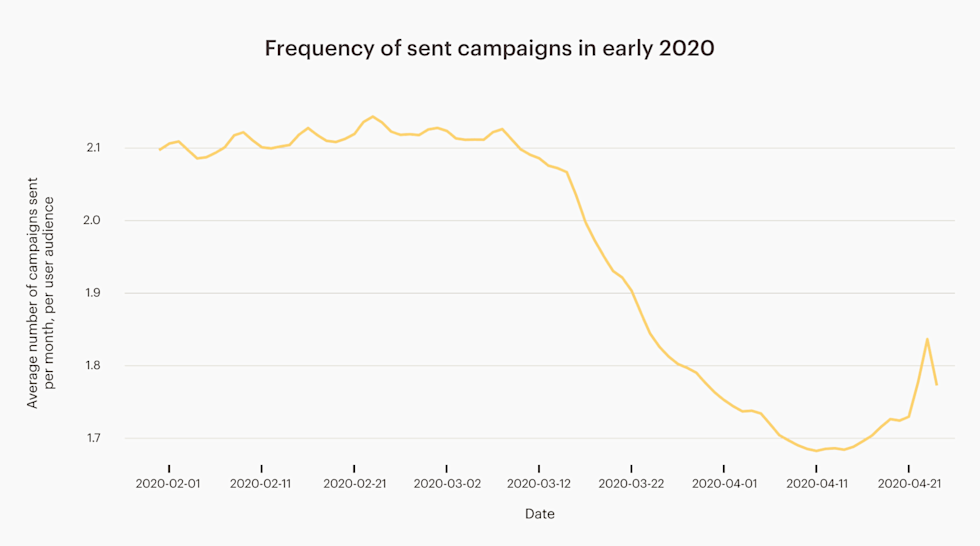COVID-19 has created new and unexpected challenges for small businesses. Widespread stay-at-home orders accompanied by economic turmoil have produced new and unpredictable consumer behaviors. We analyzed data from the Mailchimp platform to learn how marketing and engagement patterns have changed since the start of the crisis¹, and learned some insights we’re excited to share with you. Overall, we observe that audience engagement rose in early March, and now, people are highly engaged and eager to hear from businesses they value.
Mailchimp’s COVID‑19 Email Marketing Trends
This year has been stacked with unknowns. But thanks to our data analysis of Mailchimp users, we do know this: it’s the right time to engage with your digital audience.

When did these changes begin?
In early March, when the pandemic began spreading to Europe, the U.S., and elsewhere, global stock market indices lost value amidst fears of a global recession. Around this time, Mailchimp users who chose to track engagement began to see a steady increase in click and open rates, accompanied by a decrease in unsubscribe rates, compared to their previous year’s average.
The plot below shows the percent change in average engagement activity for all active Mailchimp users from January 2019 until April 2020. We can see click and open rates in March and April 2020 are higher than they were throughout all of 2019.

By March 25, almost all industries saw an increase in engagement compared to their previous year’s average.
How did different industries compare?
By March 25, almost all industries saw an increase in engagement compared to their previous year’s average. A few business types, like e-commerce, were largely unaffected and continued to perform at a level close to their historic average. Among those industries that saw a sudden shift, some saw greater increases in engagement than others.²

Restaurants and nonprofits have seen a sharp increase in email engagement. The increase might suggest restaurants with an online presence are successfully pivoting to delivery or take-out orders. For nonprofits also seeing a spike in engagement, it’s a good time to let your audience know how they can support you or take advantage of your services.

How are small businesses being affected?
Data shows that smaller businesses (those with under 2,000 contacts) saw the biggest increase in engagement since March 2019. Larger businesses still saw increased engagement, but the increase was not as dramatic. This distinction suggests people are looking for opportunities to connect with the small businesses in their communities.

Businesses are sending less often, but consumers want to hear more often.
As the world struggled to adjust to new circumstances in early March, email campaigns became less frequent than usual. The frequency of sending campaigns went down from roughly 2 campaigns a month (a campaign every 14 days) to a lowest point of about 1.5 campaigns per month (a campaign every 20 days).

But while email send frequency decreased, people favored more frequent campaigns. The plot below shows that in March and April last year, there was no discernable trend between the number of days since the last campaign and the open rate that campaign achieved. However, in March and April of 2020, subscribers overwhelmingly seem to prefer frequent campaigns, especially those sent a week apart.

We can conclude that people want to hear from businesses they’re engaged with, and in fact, they want to hear from them on a weekly basis.
Recommendations:
As customer behaviors have shifted to accommodate “the new normal” in their work, interactions, and transactions, email has proven to be an effective tool for small businesses sending weekly updates to their subscribers. Communities are eager to engage with the organizations and businesses they value, so feel confident reaching out to your audience.
Think about what’s essential to your brand, and use that messaging across your channels. Use this time to connect with your audience and think about how to deepen the loyalty within your community.
Updated April 29th, 2020.
¹ Mailchimp accounts that have opted out of data analytics were not included in this analysis.
² Mailchimp users come from a broad range of industries and represent diverse businesses and organizations; regardless of industry, however, all Mailchimp users are prohibited from importing or incorporating any sensitive personal information into any Mailchimp accounts, audiences, emails, or otherwise uploading such information to our servers.